District Museum at Wewelsburg Castle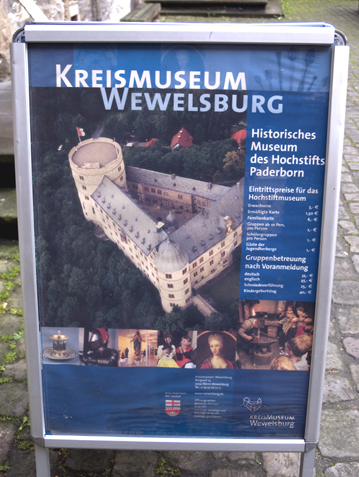 There are two museums at the Wewelsburg castle: one inside the castle and one in the former SS guardhouse, which is the first building you see when you enter the grounds of the castle. The poster shown in the photo above is for the Historical Museum of the Prince Bishopric of Paderborn. This museum, which is inside the Wewelsburg castle, gives the history of the Paderborn area from the time of the first settlement up to 1802. The city of Paderborn is famous for its stunning cathedral and for being the place where Karl der Grosse was crowned by the Pope as the first Emperor of the Holy Roman Empire on Christmas Day in the year 800. The poster shown in the photo below is for the exhibit called "Wewelsburg 1933 - 1945 Cult and Terror Center of the SS." Although the sign is located in front of the entrance to the Museum in the castle, the SS exhibit is in the former SS guardhouse.  In the former SS guardhouse are exhibits, set up in 1982, which portray the years 1933 - 1945 when the Nazis were planning an SS education center in the North tower of the Castle. The title of this museum is "Wewelsburg 1933 - 1945 Cult and Terror Center of the SS." Photos of this exhibit and pictures of the castle can be seen on this web site. Heinrich Himmler's Great Chair can be seen at this link. In the same building is an exhibit, set up in 1984, about the ethnic cleansing of Germans living on German-occupied land in Poland that was given back to the Poles after World War II. The title of this exhibit is "Germans in Eastern Central Europe - Flight - Expulsion - Integration." It concerns the expulsion of ethnic Germans from the Posen area of Poland after World War II. The Niederhagen concentration camp, originally set up for the prisoners who were working on the reconstruction of the Wewelsburg North tower between 1939 and 1943, was turned into a Displaced Persons camp for the ethnic Germans who had been expelled. The photo below shows a 17th century fireplace, which is the first thing you see to your left when you enter the door to the Museum in the castle. Notice that the fireplace has no chimney; it is a reconstruction. On both sides of the fireplace are areas where visitors can sit and relax. Visitors must purchase a ticket to see the Museum at a desk to the right of the fireplace. 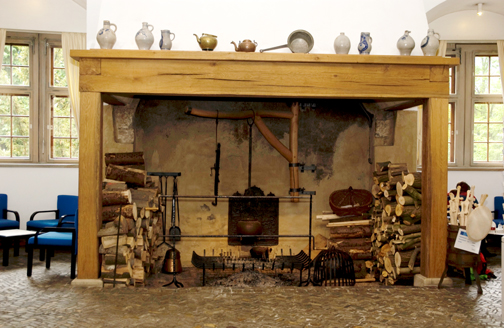 There are books and postcards for sale at the reception desk, although none in English. The receptionist, who was there when I visited in May 2008, could not speak English. There is an elevator for visitors to the castle, but the door to the elevator, which is outside the castle, is kept locked and one must ask at the reception desk for an attendant to open it. When a visitor wants to return to the ground floor, he or she must use a buzzer to call the attendant to come up to the top floor to open the door to the elevator. A diagram of the castle and the location of the exhibits in the District Museum is on this web page. The two photos below show the first room that you see on the ground floor of the castle. It has exhibits about the Knights of old. 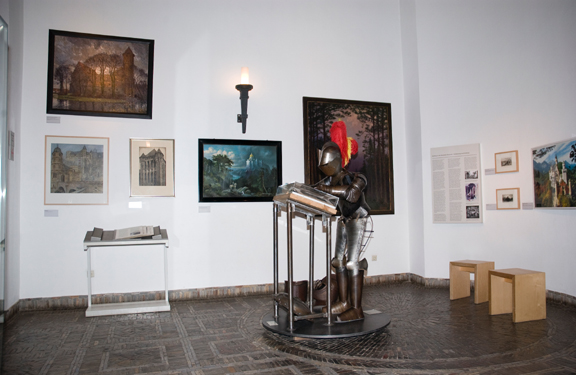 According to information given at the District Museum at Wewelsburg, weddings of SS men were performed in the room shown above, which is just off the reception room for the Museum. Another view of the same room is shown in the photo below. 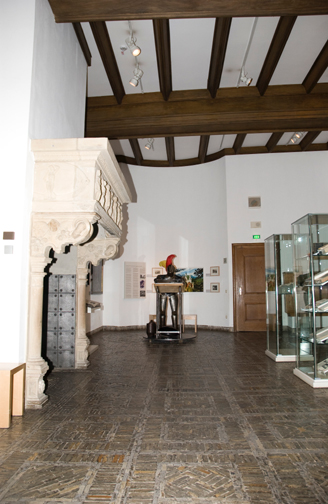 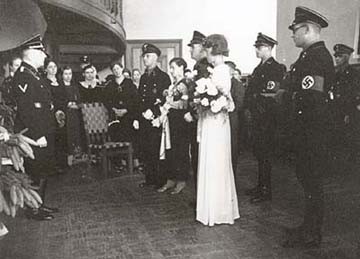 Although Hitler and Heinrich Himmler, the leader of the SS, were both baptized as Catholics, they wanted Germany to return to its original pagan religion. SS men were encouraged to have a marriage consecration called SS-Eheweihen instead of a church wedding. Some of these SS marriages took place at the Wewelsburg castle. Heinrich Himmler officiated at some of the ceremonies. The photo above shows a wedding in what appears to be the reception room of the current Youth Hostel on the east side of the Wewelsburg castle. Notice the staircase in the upper right hand corner. In the West tower, on the ground floor of the castle, is an exhibit called The Maids' Quarters. It shows a window recess that was walled off in 1806 to create a tiny room to be used as sleeping quarters for the maids. In the basement of the West tower is an exhibit called "The Experience of the Time in Paderborn Land before industrialization." This exhibit is shown in the photo below.  The east side of the ground floor of the castle has been converted into a Youth Hostel with an entrance from the inside courtyard. The ground floor of the East tower is not part of the Youth Hostel and it is closed to visitors. The Youth Hostel takes up most of the basement, including the basement of the East tower. On the upper floor, the Youth Hostel takes up the entire east side, including the top floor of the North tower. On the upper floor are exhibits about the history of the Paderborn area. The photo below shows one of these exhibits. This is a wagon load of possessions of the bride which had to be hauled to her new home after her wedding day. 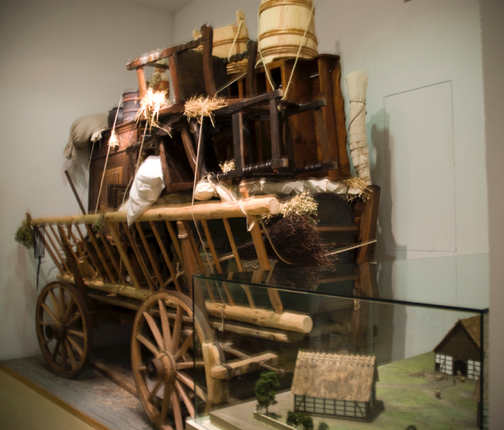 CastleNorth TowerSS Generals HallSS Vault (Crypt)Witches DungeonNiederhagen Concentration CampBack to Wewelsburg indexHomeThis page was created on July 16, 2008 |